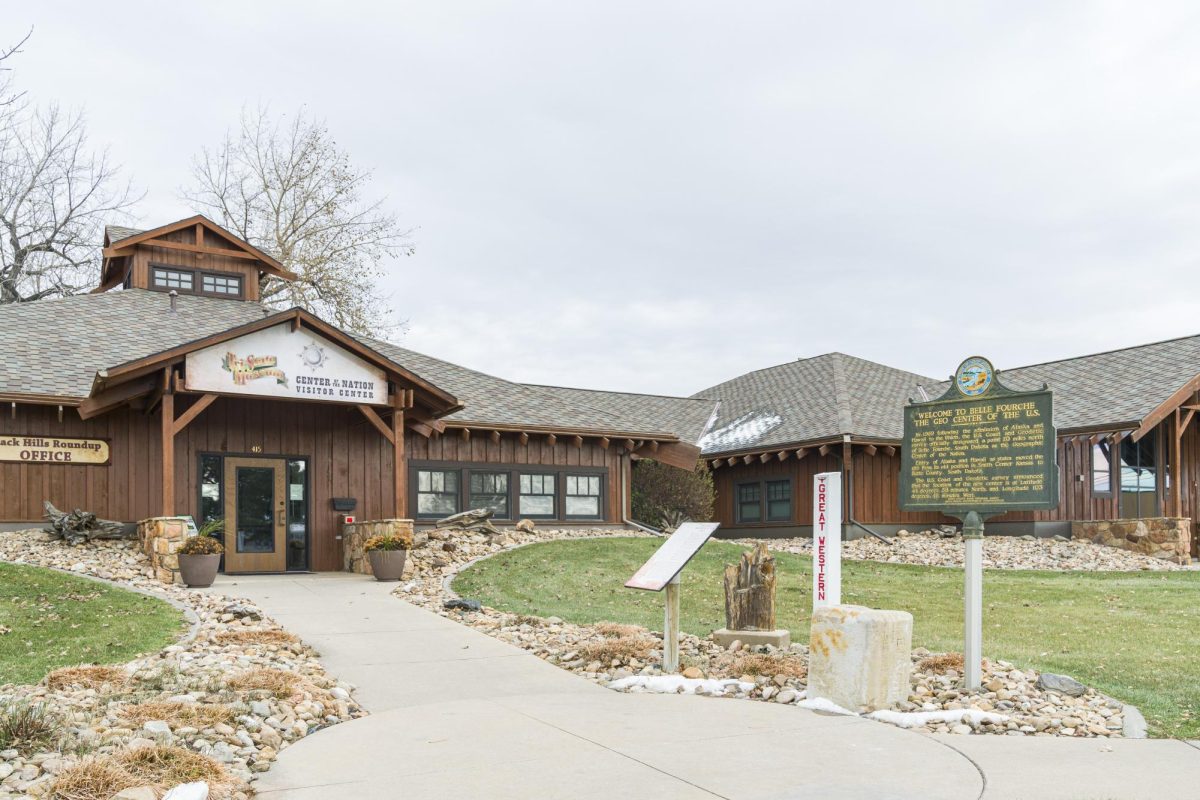The flags of all 50 states adorn the area around the compass-roseshaped Center of the Nation monument.
The monument sits right outside the Tri-State Museum in Belle Fourche, S.D., marking the small, nearby town as the geographic center of the United States. The monument, which measures 21 feet across, attracts visitors from across the nation.
“In September – and bear in mind, that’s the shoulder season, that’s not the height of the tourist season – we had 2,286 visitors, including people from 49 states and Washington D.C.,” said Kristi Thielen, director of the Tri-State Museum and Visitor Center. “This is not unusual. Only Arkansas was unrepresented. I don’t know what’s going on with the people in Arkansas!” It’s not just Americans who stop by to visit the Center of the Nation, either.
“We had visitors from Australia, Canada, France, Ireland, Italy, Poland, The UK, Norway, New Zealand, Denmark, Germany, Japan, Netherlands and Switzerland,” Thielen said. “And that’s not unusual. If I were to go back and look at the report for August, July or June, you’re going to see the same kinds of things.”
Of all the international visitors, the Tri-State Museum and the Center of the Nation see tourists from one particularly surprising country the most.
“We have visitors from Australia all year round,” Thielen said. “They’re even here in January.” While having so many visitors to
the monument is exciting for the museum, how did the center of the United States get planted in Belle Fourche, South Dakota? Considering the shape of our country, this location may seem very strange.
“Determining the geographic center of an irregular area on the Earth’s surface is a precarious business at best” reports the U.S. Department of Commerce and the National Oceanic and Atmospheric Administration in their documented survey, “Geographic Center of the United States.” “Several methods of approach are available. The one employed by the Coast and Geodetic Survey is probably besttermed as the center-of-gravity method.”
The document describes using a cardboard cutout of uniform thickness in the shape of the United States and balancing it on a singular point. The point it balances on should provide the center of the U.S. However, using this method on the 48 contiguous states lands the center near Lebanon, Kan.
This is where the center used to be, until the states of Alaska and Hawaii were admitted to the Union in 1959. Including these new states in the balancing act used to measure the center point landed the new center in its current location, 20 miles north of Belle Fourche. “I need to be candid with you.” Theilen said. “This is not the center of the center.”
What Theilen means in her admission is that although the monument sits within the margin of error of where the measured center is at, the monument itself does not sit on the actual Geographic Center of the Nation.
“There are always some people who want to know ‘Why isn’t it in the actual, actual place?’” Theilen said. “Well, because it’s in a ranchers field…it’s private property. And who’s going to pay for a monument of some sort when it’s out in a rancher’s field?”
Although the monument dedicated to the center is not in the measured location, anyone is welcome to go find the actual center
of the nation. The rancher who owns the land sometimes places an American flag on the spot marked as the center and visitors who are willing to make the 35 minute drive north are welcome to see the actual location.
“Every now and then, we’ll get somebody who will rant and rave about ‘How come this isn’t really it?’ and ‘You don’t have the right
to say this and that,’” Theilen said. “Well, I just tell them, you can go see the actual center.”
While it stands to reason that building a monument in the middle of an empty field isn’t a great investment, why did the monumented up at the Tri-State museum?
“Technically, [the center] doesn’t [relate to the museum],” Theilen said. “The Tri-State is a museum about three states, South Dakota,
Wyoming and Montana. It was put here because the expectation was to increase visitation to both by having them within the same complex.”
While the Tri-State Museum was open to having the monument, placing it in Belle Fourche initially had some backlash from some of
the locals.
“There was some controversy, particularly among downtown business people, about whether or not the chamber should be spending money on this kind of thing,” Thielen said. “I don’t think they could see its attractiveness to the public. The chamber, nevertheless,
bravely went on and built it.”
The Center of the Nation monument is open to visitors 24 hours per day, seven days per week outside the Tri-State Museum.



